Abstract
This study examines the utilization of granite stone-crushing waste in the production of porous concrete, with a particular emphasis on the influence of aggregate composition and cement paste layer thickness on the material’s strength and density. Two types of aggregates were employed in this study: granite crushing screenings and granite crushed stone. The impact of aggregate grain size on the properties of porous concrete properties was investigated, and it was found that the use of granite screenings (2.5–5 mm) resulted in superior concrete characteristics compared to granite crushed stone (5–10 mm). This study puts forward a method for optimizing the composition of porous concrete to achieve an optimal balance of compressive strength and density. A method for the design of porous concrete was proposed, incorporating experimental results and the dependencies of strength on the water/cement ratio (W/C). Equations were developed to predict concrete strength based on W/C and cement paste layer thicknesses (CPLTs). The method provides preliminary mix proportions, which should be validated and adjusted for the final design. The findings demonstrate the potential for utilizing stone-crushing waste to produce environmentally sustainable and high-quality porous concrete.
1. Introduction
The earliest documented references to the use of porous concrete date back to the nineteenth century. In particular, Ghafoori and Dutta [] observed in their literature review that the earliest documented application of porous concrete was in the United Kingdom in the year 1852.
At the beginning of the 20th century, the concept of developing porous concrete, characterized by a significant volume of voids, was first proposed by Zhitkevich []. Subsequently, the technology of this type of lightweight concrete was studied by many researchers [,,,,,,]. The production of porous concrete requires the use of both lightweight porous aggregates and conventional heavy aggregates such as gravel or crushed stone. Along with other types of lightweight concrete, porous concrete can be employed as a material for monolithic and prefabricated wall structures, as well as for drainage systems and filters [,].
Porous concrete, also referred as pervious concrete, permeable concrete, or no-fines concrete, is a sandless concrete that is typically produced from a mixture of dense or porous gravel or crushed stone, cement, and water with a limited content of cement paste [,]. The defining characteristic of porous concrete is its distinctive structure, which comprises a greater volume of voids between the grains in comparison to conventional concrete [,].
The applications of porous concrete in various construction fields can be broadly classified into two main areas. The first area encompasses the utilization of porous concrete’s favorable heat-insulating properties, as evidenced by [,,,]. The second area pertains to the exploitation of its high permeability, as demonstrated in [,,]. This definition, which may appear contradictory at first glance, reflects the specific characteristics of the material’s structure, which determine its diverse applications.
The density of porous concrete with normal-weight aggregate usually is typically limited to 1800 kg/m3, which makes it effective for products and structures requiring enhanced strength at a relatively low density [,]. Due to its high water-passing capability, porous concrete is employed in pavement applications that facilitate the direct passage of water from precipitation and other sources, thereby reducing runoff from a site and fostering groundwater recharge [,,].
One of the areas of application for porous concrete is in the construction of wall structures. To date, there has been some experience gained in the construction of such structures with porous concrete. Additionally, porous concrete has been employed for the insulation of brick walls and in conjunction with other materials to construct two- or three-layer enclosing structures [,]. Additionally, there is evidence in the literature of the construction of monolithic walls made of porous concrete, particularly for low-rise buildings [,,].
The design of porous concrete compositions can be realized in any way, provided that a material with the specified strength, frost resistance, and density is obtained from a mixture that has the required workability with minimum cement consumption [,].
The grain size of aggregates for porous concrete is usually in the range of 5 to 40 mm. The use of more homogeneous aggregates increases the void content and reduces the density and thermal conductivity of the concrete. It also has a positive effect on lower cement consumption [,,].
The consumption of cement, aggregate, and water determines the test mixes used to produce the control cubic specimens. At the same time, the selected composition should not result in the porous concrete mix stratification. A concrete mix with a correctly selected composition is characterized by [,,,,,]:
- -
- A homogeneity and uniform coating of aggregate grains with cement paste;
- -
- An absence of cement paste trickling from aggregate grains during concrete pouring;
- -
- The absence of the stratification of the concrete mix during transport and pouring.
The existing research on design methods for porous concrete mixtures is relatively limited [,,,]. However, these design methods lack sufficient completeness and are not without certain drawbacks. For example, they do not indicate how to calculate the W/C ratio or consider the effect of aggregate grain size and the cement paste volume on concrete properties. Consequently, there is currently no generally accepted method for establishing the porous concrete mix formulation; the proportions of the porous concrete mix are always selected from experimental studies [].
Despite the numerous studies on porous concrete, they are predominantly related to pervious concrete or permeable concrete, which are materials that primarily provide high water permeability. There is a paucity of studies on porous concrete as a wall material. Furthermore, the issue of designing the composition of such concretes has not been sufficiently developed.
In light of the aforementioned considerations, the objective of this study was to investigate the impact of porous concrete composition factors on its strength and density, to develop a method for designing a concrete composition that would consider the effect of the aggregate grain size, cement paste layer thickness, and W/C ratio.
2. Materials and Methods
Two types of aggregates were used for the manufacturing of the porous concrete: granite screenings and granite crushed stone. The physical characteristics of these aggregates are given in Table 1.

Table 1.
Physical properties of aggregates.
The Portland cement class CEM I 42.5R was used to prepare all porous concretes. The water used for porous concrete mixtures was tap water.
The method of preparing porous concrete was realized as follows. First, granite screenings or crushed stone, Portland cement, and water were mixed. Subsequently, following a period of thorough mixing for a duration of 1–1.5 min, the concrete mixture was poured into a mold (cube specimens measuring 100 mm × 100 mm × 100 mm) and placed on a vibrating plate. The concrete mixture was filled into the molds in three layers, with each layer undergoing uniform compaction during vibration (frequency of 50 Hz, amplitude of 0.5 mm) using a load of 0.3 N/cm2.
The workability of the concrete mixtures was evaluated following the requirements of EN 12350-3 [] (Vebe test), with a measured time between 10 and 15 s.
The prepared specimens (Figure 1) were cured for 28 days at a temperature from 20 °C to 25 °C and a relative humidity of about 95%.
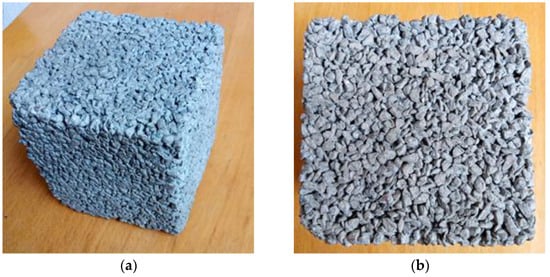
Figure 1.
(a,b) Test specimens of porous concrete with granite screenings.
Compressive strength tests were carried out at 28 days according to EN 12390-3 standard []. A hydraulic testing machine with a load capacity of 500 kN was used. The load was applied at a rate of 0.3 kN/s. Three specimens were tested for each concrete composition. The reported compressive strength was measured as an average of three specimen measurements.
3. Results
To prepare specimens from porous concrete, it was necessary to determine the optimal values of the cement paste content. An excess of cement paste leads to an increase in the density and stratification of the mixture, and a lack of paste leads to a decrease in the quality and strength of contacts between the aggregate grains.
The optimum content (volume) of cement paste Vc.p in porous concrete can be obtained from the following equation:
where δ is the thickness of the cement paste layer that covers and glues the aggregate grains, and S is the total surface area of the aggregate grains.
Vc.p = δ∙S
Problems in the technology of porous concrete are mainly related to the variability of the S-value caused by the heterogeneity of aggregates in terms of grain composition and grain shape. The heterogeneity of aggregates is not only meant in cases of low quality. Even when all the rules and standards are fully complied with, i.e., when aggregates are fractionated and meet the requirements of the standards, their total surface area varies significantly (within 20% or more) []. Aggregate heterogeneity leads to concrete heterogeneity, and for porous concrete, this factor is much more significant than for conventional concrete.
In the presented experiment, the surface area of the aggregate grains was determined using two equations.
- Equation (2) is recommended by [] to calculate the specific surface area of concrete aggregates:
Assuming that the aggregate is mono-fractional and all grains remain on the 5 mm sieve, Equation (2) can be given as follows (3):
Considering that the bulk density of crushed stone, determined experimentally, was 1530 kg/m3, the specific surface area of the grains will be Sa = 1.404/1.530 = 0.918 m2/kg.
- 2.
- For granite screenings of the 2.5–5 mm fraction (grain size typical for construction sand), the specific surface area can be calculated by the formula of A. Ladinsky []:
Assuming that a pure mono-fractional screening of the 2.5–5 mm fraction was used, it can be considered that there is only a 2.5 mm residue on the sieve. Therefore, Equation (4) is written as follows:
Cube specimens with a size of 100 mm × 100 mm × 100 mm were prepared from porous concrete at the two specified fractions. The water/cement ratio was varied (0.35, 0.4, 0.45, 0.5) and the cement paste layer thickness (CPLT) was set at different levels. The cement consumption was calculated from Equation (1). Then, the cement consumption (kg) is
where C is the cement consumption per 1 L of porous concrete, kg; Vc.p is the volume of cement paste on aggregate grains calculated by Equation (1); ρc is the cement density (3.1 kg/dm3); and W/C is the water/cement ratio.
The consumption of aggregate per 1 L of porous concrete was taken to be equal to the bulk density of the aggregate used (for grains of 2.5–5 mm, 1.55 kg; for grains of 5–10 mm, 1.53 kg).
The conventional size (diameter) of the aggregate grain was assumed to be equal to the lower size of the fraction.
Preliminary tests on concrete with a density of 1600–1800 kg/m3 using aggregates with a grain size of 2.5–5 mm and 5–10 mm showed that the CPLT on the aggregate grains varied from 100 to 150 microns on average. Therefore, three thickness values were taken for these tests: 100, 125, and 150 microns.
The experimental and calculated parameters of the aggregate (granite screenings, fraction 2.5–5 mm) are given in Table 2. The mixture compositions at different CPLTs and different water/cement ratios, as well as the values of strength and density, are given in Table 3.

Table 2.
Experimental and calculated characteristics of aggregate (granite screenings) for porous concrete.

Table 3.
Concrete mixture compositions (per 1 dm3), compressive strength values at 28 days and density at different cement paste layer thicknesses (CPLTs).
Figure 2 shows the dependence of the porous concrete compressive strength on W/C at different CPLTs.
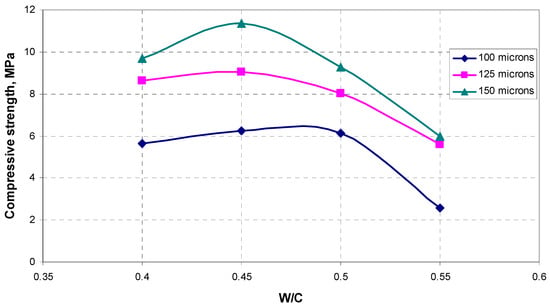
Figure 2.
Dependence of porous concrete compressive strength on W/C and CPLT (aggregate: granite screenings).
As can be seen from the shown data, when using a fraction of 2.5–5 mm with a CPLT of 150 microns, the greatest strength is obtained for W/C = 0.45. As the W/C decreases to 0.4, the strength decreases from 11.4 to 9.7 MPa. At a thickness of 125 microns, the highest strength is also achieved at a W/C of 0.45, but the difference between the strengths at W/C values of 0.4 and 0.5 is not significant. At a layer thickness of 100 microns, the strength at the values of W/C 0.45 and 0.5 is almost the same.
Such peculiarities can be explained by the fact that for each composition of porous concrete that differs in cement consumption, there is an optimal value of W/C from which both upward and downward variations are undesirable. An insufficient amount of cement paste leads to a reduction in the quality and strength of contacts between the grains. At the same time, an excess of cement paste is useless because it fills the voids between the grains and is essentially a ballast. In addition, it can lead to the stratification of the concrete mix.
The experimental and calculated parameters of the aggregate (granite crushed stone, fraction 5–10 mm) are given in Table 4. The composition of the mixes at different CPLTs and different water/cement ratios, as well as the values of strength and density, are given in Table 5. The calculations were calculated in the same way as for the granite screenings of 2.5–5 mm fraction.

Table 4.
Experimental and calculated characteristics of aggregate (granite crushed stone) for porous concrete.

Table 5.
Concrete mixture compositions (per 1 dm3), compressive strength values at 28 days, and density at different cement paste layer thicknesses (CPLTs).
As can be seen from the above data, when using a crushed stone fraction of 5–10 mm with a layer thickness of 150 microns, the highest strength is achieved at W/C = 0.45. At the same time, when the W/C decreases to 0.4 or increases to 0.5, the strength decreases slightly. At a W/C of 0.35, the strength decreases sharply (to 2.8 MPa) due to insufficient mix workability.
Figure 3 shows the dependence of the porous concrete compressive strength on W/C at different CPLTs.
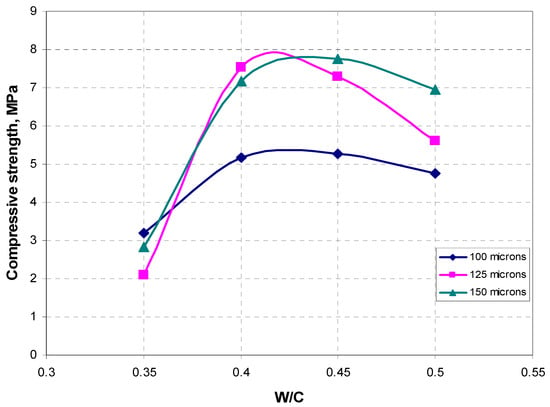
Figure 3.
Dependence of porous concrete compressive strength on W/C and CPLT (aggregate–granite crushed stone).
At a CPLT value of 125 μm, the highest strength is achieved at a W/C of 0.4, but the difference between the strengths at a W/C of 0.4 and 0.45 is not significant. At a CPLT value of 100 μm, the strength is lower than at thicknesses of 125 and 150 μm.
Comparing the results obtained for the two aggregates, the following can be noted. The compressive strength of porous concrete using screenings is higher than that using crushed stone at all layer thicknesses and different W/C ratios. Thus, at W/C = 0.45 and δ = 150 μm, the strength for the 2.5–5 mm fraction is 11.4 MPa (Figure 4), while for the 5–10 mm fraction, it is 7.6 MPa, which is almost 50% higher. This can be explained by the larger amount of contact between the grains of the finer fraction and, accordingly, by the higher strength. At the same time, the density is also higher for the 2.5–5 mm fraction (Figure 5), since the void content of such concrete is smaller.
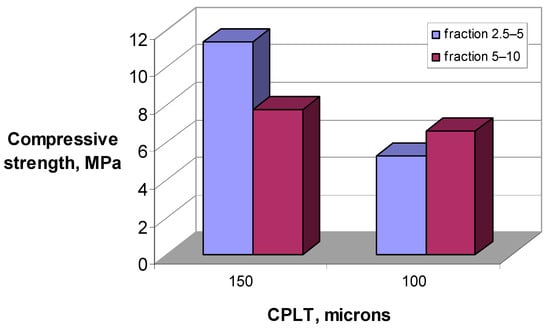
Figure 4.
Compressive strength of porous concrete on different aggregate fractions at W/C = 0.45.
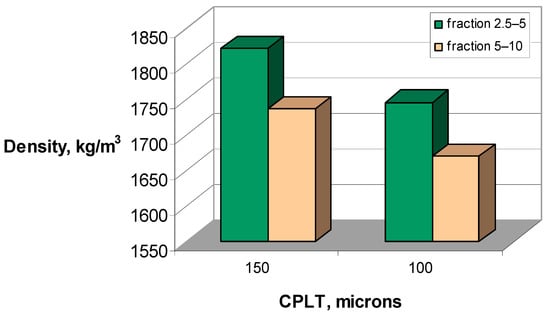
Figure 5.
The density of porous concrete on different aggregate fractions at W/C = 0.45.
Considering the above, the better quality of the porous concrete with an aggregate fraction of 2.5–5 mm can be confirmed by the coefficient of structural quality (CSQ), which is determined by the ratio of compressive strength to the relative density of concrete. As can be seen in Figure 6, the CSQ for concrete at the 2.5–5 mm fraction is higher than for the 5–10 mm fraction. This means that despite the slightly higher density of such concrete, it has significantly higher strength, indicating a better quality of porous concrete at the 2.5–5 mm fraction.
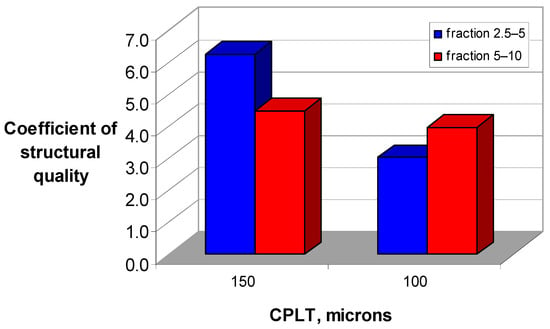
Figure 6.
Coefficient of the structural quality of porous concrete on different aggregate fractions at W/C = 0.45.
The results presented above cover only a part of the possible studies related to the effect of CPLT and aggregate grain size on the properties of porous concrete.
Further research should be aimed at investigating the effect of plasticizer addition on the properties of porous concrete by using aggregates of different types and at different grain sizes.
4. Design of Porous Concrete Composition Based on Granite Screenings
Based on the experimental data, three equations were obtained that describe the dependence of the strength of porous concrete made with granite screenings on the W/C ratio at different CPLTs.
The sequence of operations when designing a porous concrete composition on granite screenings is as follows.
- According to Table 6, define the CPLT and the corresponding dependence of the strength on the W/C, depending on the strength required.
 Table 6. Dependencies of porous concrete strength on W/C at different cement paste layer thicknesses on aggregate grains.
Table 6. Dependencies of porous concrete strength on W/C at different cement paste layer thicknesses on aggregate grains. - Calculate the volume of cement paste from Equation (1) for a known aggregate surface area (defined from Equation (4)).
- Calculate the cement consumption from Equation (6).
- The water content is obtained by multiplying the cement consumption by the water/cement ratio: W = C∙(W/C).
- The consumption of the granite screenings is equal to its bulk density: GS = ρb.d.
- From the corresponding dependence in Table 6, calculate the approximate value of the concrete density, given the known strength.
5. Numerical Example
The efficiency of the proposed method is demonstrated in a numerical example aimed at the design of a porous concrete composition.
Condition: Calculate the composition of coarse concrete prepared on granite screenings of 2.5–5 mm fraction with 28-day compressive strength of 11 MPa. The bulk density of the 2.5–5 mm fraction is 1.55 kg/dm3. The density of cement is 3.1 kg/dm3.
- According to Table 6, the required strength can be obtained with a CPLT of 150 mm.
- Determine the strength equation corresponding to δ = 150 mm:
fc = 445∙(W/C) − 496∙(W/C)2 − 89
By solving the quadratic equation, calculate the W/C:
11 = 445∙(W/C) − 496∙(W/C)2 − 89;
−496∙(W/C)2 + 445∙(W/C) − 100 = 0.
W/C = 0.45
- 3.
- The specific surface area of the aggregate grains is
- 4.
- The required volume of cement paste will be
Vc.p = δ∙S = 0.150 × 1.27 = 0.1905 m3
- 5.
- Cement consumption:
- 6.
- Water content:
W = C∙(W/C) = 246 × 0.45 = 110 L
- 7.
- The consumption of granite screenings will be equal to its bulk density:
GS = 1550 kg
- 8.
- The approximate value of concrete density is calculated by the corresponding equation (Table 6):
ρ = 1763 + 5∙fc = 1763 + 5 × 10 = 1813 kg/m3
The final porous concrete composition (for 1 m3 of mix) is as follows: 246 kg of cement, 110 L of water, 1550 kg of granite screenings with a fraction of 2.5–5 mm.
The above mix design method, like any other concrete mix design method, gives a preliminary mix proportion. The calculated values should then be tested and adjusted to obtain the final mix design values.
6. Conclusions
Based on the presented experimental research campaign, the following conclusions can be drawn:
- The compressive strength of porous concrete made with granite screenings (2.5–5 mm) was found to be higher than that of concrete made with granite crushed stone (5–10 mm). For instance, at a water/cement ratio (W/C) of 0.45 and cement paste layer thickness (CPLT) of 150 microns, the strength of concrete with granite screenings was 11.4 MPa, while with granite crushed stone, it was 7.6 MPa. The finer fraction (2.5–5 mm) resulted in a higher concrete density due to the reduced void content, enhancing strength and structural quality.
- There is an optimum W/C ratio for each aggregate type and fraction. Any deviation from this optimum ratio, whether increasing or decreasing, has been shown to result in a reduction in compressive strength. For example, the highest strength for both granite screenings and crushed stone was achieved at a W/C of 0.45, with notable decreases in strength observed at both lower and higher ratios.
- The compressive strength of porous concrete was observed to increase with CPLT; however, an excess cement paste was found to have the potential to fill the voids between grains, acting as a ballast rather than contributing to grain bonding. The study determined that a CPLT of 150 microns was optimal for achieving the highest strength for both granite screenings and crushed stones.
- A clear relationship was established between the density and strength of porous concrete, with higher strength corresponding to higher densities. This was particularly evident with the use of finer aggregates, which resulted in concrete with higher compressive strengths and densities.
- The coefficient of structural quality (CSQ), defined as the ratio of compressive strength to the relative density of concrete, was found to be higher for concrete produced with granite screenings in comparison to concrete produced with granite crushed stone. This suggests that the quality of porous concrete with finer aggregates is increased.
- The study put forward a method for the design of porous concrete compositions based on the optimal combination of cement paste volume, W/C ratio, and aggregate type and size. This method allows for the creation of tailored concrete mixes to efficiently achieve desired strength and density properties.
The findings provide valuable insights for the practical application of porous concrete in construction, particularly for low-rise buildings and other structures where both permeability and strength are critical. The research confirms that appropriate selection and proportioning of materials can significantly enhance the performance of porous concrete.
Author Contributions
Conceptualization, L.D.; methodology, L.D. and O.B.; software, O.B.; validation, L.D. and T.T.; formal analysis, O.B. and T.T.; investigation, L.D. and O.B.; resources, K.M.; data curation, O.B.; writing—original draft preparation, L.D., O.B., T.T. and K.M.; writing—review and editing, T.T. and K.M.; visualization, O.B. and T.T.; supervision, L.D.; project administration, K.M.; funding acquisition, K.M. All authors have read and agreed to the published version of the manuscript.
Funding
The research was supported by the Polish National Agency for Academic Exchange under activities complementary to those undertaken by the University as part of the European University alliance initiative entitled STARS EU, an academic cooperation with Ukrainian universities, grant no. BNI-UE-2023-8. This research was co-funded by the Polish National Centre for Research and Development in Poland, under the M-ERA.NET 3 program, grant number M-ERA.NET3/2021/144/3D-FOAM/2022.
Institutional Review Board Statement
Not applicable.
Informed Consent Statement
Not applicable.
Data Availability Statement
Data are contained within the article.
Acknowledgments
Author K.M. is supported by the Foundation for Polish Science (FNP).
Conflicts of Interest
The authors declare no conflicts of interest.
References
- Ghafoori, N.; Dutta, S. Building and Non-pavement Applications of No-Fines Concrete. J. Mater. Civ. Eng. 1995, 7, 286–289. [Google Scholar] [CrossRef]
- Zhitkevich, N.A. Concrete and Concrete Works; SPB: Nellore, India, 1912. [Google Scholar]
- Skramtaev, B.G. Large-Porous Concrete and Its Application in Construction; Gosstroyizdat: Moscow, Russia, 1955. [Google Scholar]
- Itskovich, S.M. Porous Concrete (Technology and Properties); Gosstroyizdat: Moscow, Russia, 1977. [Google Scholar]
- Harber, P.J. Applicability of No-Fines Concrete as a Road Pavement. Bachelor’s Thesis, University of Southern Queensland, Toowoomba, Australia, 2005. [Google Scholar]
- Beeldens, A.; Van Gemert, D.; Caestecker, C.; Van Messem, M. Mechanical Properties and Structure of Porous Concrete. In Proceedings of the 8th International Symposium on Concrete Roads, Lisbon, Portugal, 13–16 September 1998; pp. 129–134. [Google Scholar]
- Tennis, P.D.; Leming, M.L.; Akers, D.J. Pervious Concrete Pavements; Portland Cement Association, Skokie, Illinois, and National Ready Mixed Concrete Association: Silver Spring, MD, USA, 2004; p. 36. [Google Scholar]
- Li, L.; Feng, J.; Zhu, J.; Chu, S.; Kwan, A. Pervious concrete: Effects of porosity on permeability and strength. Mag. Concr. Res. 2019, 71, 69–79. [Google Scholar] [CrossRef]
- Alalea, K.; Jasmine, M.; Hong, S.; Christopher, R. Structural and hydrological design of permeable concrete pavements. Case Stud. Constr. Mater. 2021, 15, e00564. [Google Scholar]
- Qosai, S.R.M.; Safa, A.H.; Basim, M.M.; Zainab, S.A.-K.; Ali, A.S. Applying of No-fines concretes as a porous concrete in different construction applications. Period. Eng. Nat. Sci. 2021, 9, 999–1012. [Google Scholar]
- Patil, P.S.; Sonar, I.P.; Shinde, S. No fine concrete. Int. J. Concr. Technol. 2017, 3, 18–30. [Google Scholar]
- Hearn, N.; Hooton, R.D.; Mills, R.H. Pore structure and permeability. In Significance of Tests and Properties of Concrete and Concrete-Making Materials; ASTM International: West Conshohocken, PA, USA, 1994. [Google Scholar] [CrossRef]
- Yu, F.; Guo, J.; Liu, J.; Cai, H.; Huang, Y. A review of the pore structure of pervious concrete: Analyzing method, characterization parameters and the effect on performance. Constr. Build. Mater. 2023, 365, 129971. [Google Scholar] [CrossRef]
- Ghosh, S.K.; Chaudhury, A.; Datta, R.; Bera, D.K. A review on performance of pervious concrete using waste materials. Int. J. Res. Eng. Technol. 2015, 4, 105–115. [Google Scholar]
- Carsana, M.; Tittarelli, F.; Bertolini, L. Use of no-fines concrete as a building material: Strength, durability properties and corrosion protection of embedded steel. Cem. Concr. Res. 2013, 48, 64–73. [Google Scholar] [CrossRef]
- Wong, J.M.; Glasser, F.P.; Imbabi, M.S. Evaluation of thermal conductivity in air permeable concrete for dynamic breathing wall construction. Cem. Concr. Compos. 2007, 29, 647–655. [Google Scholar] [CrossRef]
- Zhang, Y.; Li, H.; Abdelhady, A.; Yang, J.; Wang, H. Effects of specimen shape and size on the permeability and mechanical properties of porous concrete. Constr. Build. Mater. 2021, 266, 121074. [Google Scholar] [CrossRef]
- JiaHao, L.; Lian, F.C.; Hejazi, F.; Azline, N. Study of properties and strength of no-fines concrete. IOP Conf. Ser. Earth Environ. Sci. 2019, 357, 012009. [Google Scholar] [CrossRef]
- Rahesh, H.; Mini, K.M. Mechanical and clogging characteristics of SBR modified pervious concrete reinforced with geogrids—A Functional Data Analysis approach. Constr. Build. Mater. 2023, 412, 134780. [Google Scholar] [CrossRef]
- Rounak, P.; Partha, P.S. Developing a model of porous concrete-filled rigid pavement. Mater. Today Proc. 2023, in press. [Google Scholar] [CrossRef]
- Salih, S.A.; Fidel, T.A. Some Durability Test of No-Fine Concrete. J. Eng. 2016, 22, 15–30. [Google Scholar] [CrossRef]
- Jaya, R.H.Y.P.; Yusak, M.I.M.; Hainin, M.R.; Lbrahim, M.H.W. A Review of Porous Concrete Pavement: Applications and Engineering Properties. Appl. Mech. Mater. 2014, 554, 37–41. [Google Scholar] [CrossRef]
- Kim, H.K.; Lee, H.K. Influence of cement flow and aggregate type on the mechanical and acoustic characteristics of porous concrete. Appl. Acoust. 2010, 71, 607–615. [Google Scholar] [CrossRef]
- Bhutta, M.A.R.; Tsurutab, K.; Mirzac, I. Evaluation of high-performance porous concrete properties. Constr. Build Mater. 2012, 31, 67–73. [Google Scholar] [CrossRef]
- Sánchez-Mendieta, C.; Galán, J.J.; Martinez-Lage, I. Physical and Hydraulic Properties of Porous Concrete. Sustainability 2021, 13, 10562. [Google Scholar] [CrossRef]
- Xu, G.; Shen, W.; Huo, X.; Yang, Z.; Wang, J.; Zhang, W.; Ji, X. Investigation on the properties of porous concrete as road base material. Constr. Build. Mater. 2018, 158, 141–148. [Google Scholar] [CrossRef]
- Lyu, O.; Dai, P.; Chen, A. Sandwich-structured porous concrete manufactured by mortar-extrusion and aggregate-bed 3D printing. Constr. Build. Mater. 2023, 392, 131909. [Google Scholar] [CrossRef]
- Xu, L.; Ding, X.; Niu, L.; Huang, Z.; Sun, S. Experimental Study on the Mechanical Properties and Influencing Factors of Glass Fiber-Reinforced Permeable Concrete. Materials 2023, 16, 5970. [Google Scholar] [CrossRef] [PubMed]
- ACI 522R-10; Report on Pervious Concrete. American Concrete Institute: Farmington Hills, MI, USA, 2010.
- Zheng, M.; Chen, S.; Wang, B. Mix design method for permeable base of porous concrete. Int. J. Pavement Res. Technol. 2012, 5, 102. [Google Scholar]
- Nguyen, D.H.; Sebaibi, N.; Boutouil, M.; Leleyter, L.; Baraud, F. A modified method for the design of pervious concrete mix. Constr. Build. Mater. 2014, 73, 271–282. [Google Scholar] [CrossRef]
- Zhang, Q.; Feng, X.; Chen, X.; Lu, K. Mix design for recycled aggregate pervious concrete based on response surface methodology. Constr. Build. Mater. 2020, 259, 119776. [Google Scholar] [CrossRef]
- Sonebi, M.; Bassuoni, M.; Ammar, Y. Pervious concrete: Mix design, properties and applications. RILEM Tech. Lett. 2016, 1, 109–115. [Google Scholar] [CrossRef]
- EN 12350-3:2019; Testing Fresh Concrete—Part 3: Vebe Test. CEN—European Committee for Standardization: Bruxelles, Belgium, 2019.
- Dvorkin, L.; Nwaubani, S.; Dvorkin, L. Construction Materials; Nova Science Publishers: Hauppauge, NY, USA, 2013. [Google Scholar]
Disclaimer/Publisher’s Note: The statements, opinions and data contained in all publications are solely those of the individual author(s) and contributor(s) and not of MDPI and/or the editor(s). MDPI and/or the editor(s) disclaim responsibility for any injury to people or property resulting from any ideas, methods, instructions or products referred to in the content. |
© 2024 by the authors. Licensee MDPI, Basel, Switzerland. This article is an open access article distributed under the terms and conditions of the Creative Commons Attribution (CC BY) license (https://creativecommons.org/licenses/by/4.0/).